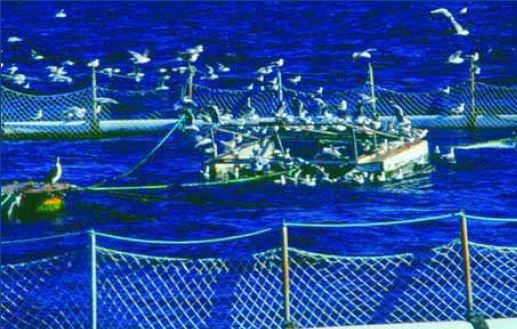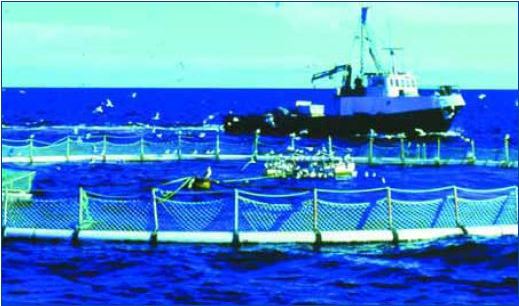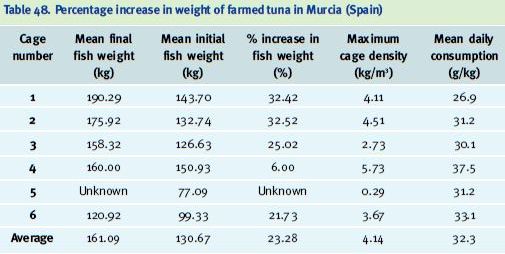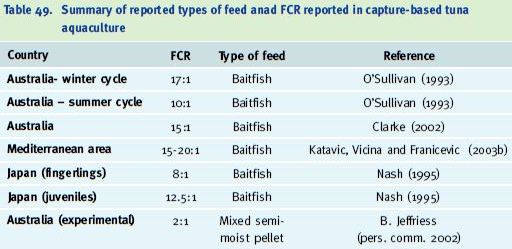Feeds and feeding regimes
Information on feeding strategies, feed conversion ratios, etc. is limited, mostly referring to Australian farming practices. Here the fattening period is short, varying from 3 to 10 months. Fat levels show a decline over winter months, supporting the fact that the summer growth produces better quality fish.
The farmed southern bluefin tuna are fed baitfish (Figure 96) six days a week, twice a day. The feed is generally presented by placing the frozen blocks of baitfish (pilchards, herrings, mackerel, squid) in a mesh within each cage. Supplementary feeding is generally done by hand. In 2001 some 20 species and about 45 000 tonnes of baitfish were used, sourced locally and overseas (about two thirds of this being imported, primarily from the USA and northern Europe). Typically, over a farming season, food conversion ratios are about 10-15:1 using baitfish. The average size of the southern bluefin tuna increases by 10-20 kg, and mortality rates are between 3-7% (Clarke 2002). Conversion ratios vary with the culture season (10:1 in summer time and 17:1 in winter time) and with tuna size – smaller tuna have better FCRs than larger ones (O’Sullivan 1993).

Figure 96. Frozen blocks of baitfish for capture-based tuna aquaculture (Photo: L. Mittiga)
The most pressing research goal of the Australian tuna farming industry has been the development of manufactured feeds to replace the use of baitfish (Montague 2003). Continuous quality improvement is compromised by the need to use a wide variety of baitfish, which have a correspondingly wide range in quality. It is not the quantity of baitfish supplied to the tuna that influences production, but the supply and quality of nutrients obtained from consuming them. If baitfish are low in protein and fat, then tuna growth will be retarded, and greater quantities of baitfish will be required to maintain the same production level. The suitability of the baitfish also depends on storage history and the standard of quality control. The characteristics of the baitfish used in tuna production varies significantly. A survey undertaken in 2000 revealed large variation in the crude protein, crude fat, free fatty acid and peroxide values present in baitfish samples (Table 46).
Table 46. Baitfish composition (www.sardi.sa.gov.au)
Parameter Range
Crude protein (% DM) 49.4 - 75.3
Crude fat (% DM) 1.9 - 36.5
Free fatty acids (% DM) 2.9 - 53.4
Peroxide value (meg/kg DM) < 0.1 - 598.0
The southern bluefin tuna is an important mariculture species in Australia but the development of manufactured feeds has been limited, due to the lack of detailed information about their nutritional requirements (van Barneveld et al. 1997). Although pelleted feeds have been developed, progress has been slow. The development of a formulated pellet for replacing baitfish is still in progress; however, there are difficulties in conducting large-scale growth trials (because of the scale of the cages necessary and the value of the experimental fish) to evaluate their quality (Bransden, Carter and Nowak 2001). Often Atlantic salmon, Salmo salar, are used in screening experimental feeds, as a “surrogate” species (Carter et al. 1999; Bransden, Carter and Nowak 2001) in nutritional research on southern bluefin tuna. However, this has its limitations, since salmon have different life strategies and different nutrient requirements, so that it is unlikely that the resulting diets will be optimal for tuna culture.
Encouraging results were obtained in 1997-1999 in South Australia through a small-scale research project on the tuna research farm of SARDI, in conjunction with the CRC for Aquaculture. A manufactured feed substituted for pilchard feeds (Figure 97) provided comparable growth rates, product quality and market price. Problems regarding sub-optimal acceptance and palatability of pellet feeds by the southern bluefin tuna, production costs and possible Japanese market resistance to fish reared on pelleted feeds, were some of the reasons cited why farmers were reluctant to evaluate the recommended manufactured feed in their commercial farms. In a trial

Figure 97. Baitfish feeding for capture-based tuna aquaculture
performed in 2001, two groups of tuna were fed exclusively on manufactured feed and the results compared to those obtained by tuna fed on baitfish. The fish, later harvested for sale in Japan, grew on the pelleted diet (40% protein; 20% oil), displayed longer flesh shelf-life and gained average prices of ? 3 027/kg (www.sardi.sa.gov.au); an FCR of around 10:1 was obtained with baitfish, while the use of mixed pelleted feed achieved an FCR of about 2:1 (B. Jeffriess, pers. comm. 2002). SARDI (South Australian Research and Development Institute) research now focuses on improving the palatability of the pellets and improving feed management techniques to optimise FCR (www.sardi.sa.gov.au); Australian researchers are also working on extruded pellets.
In the Mediterranean area tuna are also fed baitfish. In the work of Katavic, Vicina and Franicevic (2003a) tuna were fed for the first time nine days after being stocked. They were given raw, defrosted small pelagic fish, mostly (87.9%) herrings (Clupea harengus); the remaining feed was composed of raw defrosted sardines, Sardina pilchardus (6.7%) and cephalopods (5.4%). Feed was distributed six days per week, twice a day, in the morning and the late afternoon. The daily feeding rate gradually increased until the end of July, when the tunas were fed with a daily feed quantity equalling to 7.7% of their biomass. According to feeding records, which covered the culture period of 155 days, it was calculated that the tunas were given a total of 399 005 kg of feed. The maximum daily feeding rate was 9.8%, and the average daily feeding rate was approximately 5.1% of the total fish biomass (Katavic, Vicina and Franicevic 2003a). Unfortunately the FCR value was not reported in this paper. In Croatia, small pelagic fish are used (e.g. frozen herrings Clupea harengus, pilchard Sardina pilchardus, round sardinella Sardinella aurita, and short-fin squid Illex coindetii) at approximately 5-8%/day of estimated biomass during summer season. In 2001 about 15 000 tonnes of baitfish were used, sourced both from the North Sea and locally (Katavic, Vicina and Franicevic 2003a,b). During the fattening season, bluefin tuna are normally overfed and food conversion ratios are about 15 to 20:1. The highest feed consumption occurs at 23-25°C, with up to 10% of body biomass being fed daily; this may be reduced by half at 20°C and daily feed consumption does not exceeding 2-3% of body weight at 18°C (Katavic, Vicina and Franicevic 2003b).
An experiment using a submersible cage was conducted in Italy, in the central Adriatic sea, four marine miles off Ortona; during the four month culture cycle the daily feed ration consisted of sardines, squid (in small percentages due to their high cost) and mackerel at a daily rate that averaged 5% of the biomass inside the cage. Tuna were fed with a total of
4 376 kg of baitfish; the species used and their relative percentage are shown in Table 47. At stocking, the average weight of the tuna was 3.8 kg; after 4 months it had reached 10.8 kg. Feeding behaviour was not influenced by depth: as soon as the cage was brought to the surface, the fish responded immediately to feeding in the same way that they would have with a cage permanently moored in proximity to the surface. The underwater feeding tests showed that depth did not effect fish appetite.
Table 47. Quality and relative percentage of the fish utilized for feeding the tuna in Ortona (Italy)

Tuna are fed on Mediterranean frozen fish (e.g. herrings, sardines and mackerel) in Malta. According to (Peric 2003b), each cage was fed 1 509±361.6 kg and 1 099.3±79.0 kg of frozen feed per day during August and September respectively. The 2000 farming season in Murcia (Spain) provided the data shown in Table 48, which illustrates the weight increase of farmed tuna achieved (the length of the culture period was not reported) (Cunningham and Bejarano 2002).
Table 48. Percentage increase in weight of farmed tuna in Murcia (Spain)

An experimental farm in Morocco was fed “trash fish” – Atlantic mackerel, horse mackerel and short-fin squid. Two batches were kept in floating cages: the first batch comprised 75 giant bluefin tuna (mean body weight around 250 kg) and the second one contained 106 young bluefin tuna (mean body weight about 55 kg). The feeding behaviour of the tuna showed seasonal changes, which were particularly evident in the smaller bluefin tunas. Higher feeding activity occured in October-November and less in June-July. Feeding selectivity showed that giant bluefin tunas prefer squid, while younger bluefin tuna favour Atlantic mackerel. The size of the fish was greatly affected by samplings and mortality during the winter season. The bluefin tuna also showed a seasonal growth pattern. The annual mean rate of growth was high (50 kg/year) for the giant bluefin tuna and 75 kg/year for the young bluefin tuna (Nhhala 2002).
An experiment was undertaken by a group of scientists headed by Teruo Harada in the fisheries laboratory of Kinki University, Japan in 1990. The tuna weighed 250 g at the time of stocking, and reaching 110 kg after 10 years and 145 kg after 15 years. The largest tuna was 177 kg and 229 cm long at 16 years old. The fish were fed mackerels, horse mackerels, anchovies and cuttlefish (Norita 2003). The development of the rearing technology for capture-based fingerlings in Japan has been successful to some extent. If the supply of farmed fingerlings (10 cm to 20 cm in length) can be kept stable, commercial tuna aquaculture becomes practical; FCRs of 10:1 have been achieved. Juveniles are captured by angling and on-grown in large floating cages. When conditions are stable, and the ambient water temperature remains above 15°C, mortality is low and growth is exceptional. According to Nash (1995) young fish, when captured, weigh between 100-200 g, but can attain 6 kg in one year, 20 kg in two, and over 60 kg in four years, depending on the feed availability, water quality and temperature. In captivity, the diet provided for bluefin tunas is similar to that for yellowtails, comprising of the available resources (squid, small scombroids, and trash fish). Feed conversion efficiency is better in younger fish, however. The ratio of wet weight of feed to weight gain was about 8:1 in the early months of growth, but increased to about 12.5:1 by the time fish reached 3 years of age.
One of the most important challenges in tuna capture-based aquaculture remains the development of a feed capable of substituting for baitfish. Raw fish diets have some inherent disadvantages, e.g. high food conversion ratios (Table 49), the risks of pollution and disease, and variable quality; these problems promoted the research into manufactured feed for farmed tuna. The manufactured feeds developed so far have focused on moist and semi-moist feeds; however dry feeds have also been accepted. Diet formulation development has been largely based on muscle composition and natural prey species (Smart, Sylvia and Belle 2003). These studies, not unexpectedly indicate that tuna need a high energy, high protein, low carbohydrate diet, typical of a high order, opportunistic carnivore. Nevertheless, the current rearing systems are based on the growing of wild animals (Essed et al. 2003), which makes their adaptation to inert diets difficult.
Table 49. Summary of reported types of feed anad FCR reported in capture-based tuna aquaculture

Given the high volumes of baitfish needed to feed tuna, there is a potential negative affect on the associated fisheries on small local populations (see Chapter 3). New feeds and feeding regimes are urgently needed for the further development of tuna capture-based aquaculture. Collaboration between the industry and research scientists must be the basis for projects to develop artificial diets that can achieve better feed conversion ratios and control meat quality and the relative production costs of this type of aquaculture.